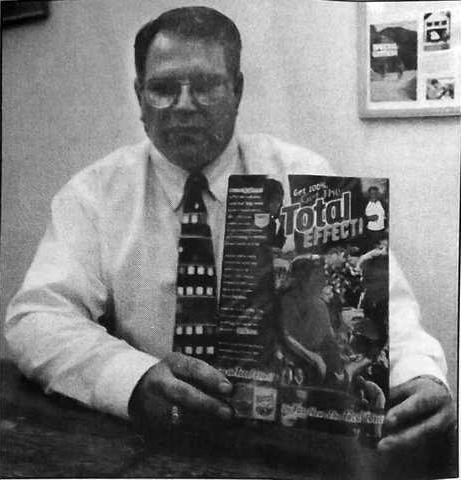Each week we’ll take a step back into the history of Great Bend through the eyes of reporters past. We’ll reacquaint you with what went into creating the Great Bend of today, and do our best to update you on what “the rest of the story” turned out to be.
Earlier this week, the National Oceanic and Atmospheric Administration released a climate prediction for the United States, and forecasts that a strong El Niño is building, one that could rival the intensity of the record 1997 event that influenced weather-related havoc across the globe, from mudslides in California to fires in Australia.
“There is a greater than 90% chance that El Niño will continue through Northern Hemisphere winter 2015-16, and around an 85% chance it will last into early spring 2016,” NOAA said in a statement.
So, this week Out of the Morgue looks back at the El Nino of 1997 and 1998.
August
In August, a 105 Nell Miller was spotlighted as the oldest person living in Barton County in a feature story on the “50s plus” page of the Great Bend Tribune.
Nell Miller was reported to be living at Sterling House. She was born in 1892, and came to Great Bend with her family in 1910. She had recently graduated from high school and attended the Normal College run by the Dominican Sisters. She and her sister taught in one-room school houses until she married Traver Perry Newell in 1915. Together they started Newell Plumbing Company. When her husband died in 1933, she took over the business, and ran it until she retired in 1966 at the age of 74, Susan Thacker reported.
The temperature this week was predicted to be hot and sunny this week in 1997, and in Bullhead City , Ariz., the temperature reached a high of 111, and in West Yellowstone, Mont., it reached a low of 34.
November
When Thanksgiving came around in 1997, Al Silverstein of Great Bend talked with the Tribune about his father, Milt Silverstein, who at was featured on the front of Total cereal boxes because he was one of the fastest men in the 75-79 age group. He competed in the 1997 National Senior Sports Classic, winning the 100 and 200-meter dashes with times of 14.59 and 20.9 seconds respectively, then managing editor Daren Watkins wrote.
“He has always been a natural athlete,” Al Silverstein said. “He used to start standing up, but now he is coming out of the blocks. When I visit him, I just try to keep up.”
Chances are, Silverstein had little trouble running in the mild weather experienced the week of thanksgiving in 1997. Temperatures were in the mid 60s for highs and upper 30s for lows. The national summary stated:
:Rain will soak an area from Tennessee to western Virginia tomorrow, as thunderstorms rumble across the Gulf Coast states. Some snow will spread eastward from the Dakotas into Wisconsin. Mild weather is in store for the central and southern Plains. Sunshine will prevail around the Southwest, while rain will return to western Washington.
December
Monthly snowfall totals reached 14.9inches at Dodge City, KS, 10.9 inches at Kansas City, Mo., and 15.2 inches in Moline, Ill. Still, warmer than average temperatures were the norm locally.
January
The East coast experienced heavy storms, including ice storms, resulting in losses of life.
February
In Great Bend, elected officials and business people were invited to visit a Seaboard Farms pork processing plant in Guymon, Okla., and returned excited about the prospect of the company regionalizing its operation to include a pork processing plant in either Great Bend, Garden City, or Amarillo, Texas.
Again, while the rest of the country experienced heavy rains, thunderstorms, and chilly air , the Southern plains stayed sunny and mild. Especially impressive was the lack of night-time cold, as temperatures remained above the 20 degree F mark for the entire month in Topeka, the first occurrence since records began 102 years before. On Groundhog Day, 1998, the daytime temperatures in Great Bend were in the mid 40s, and the night time temps were in the low 30s.
Great Bend Tribune readers learned that 370,000 people were without power that day in southern Florida, after a strong storm that caused one death and produced tornadoes hit the Miami area. Gusts of 104 mph wind hit Miami International airport and flipped police planes and helicopters.
Also, community activists Greg and Lana Brown were speaking out and holding meetings to express opposition to the Seaboard Farms proposal. In the end, Seaboard went elsewhere, considered a win by some and a loss by others.
The remainder of the 1997 El Nino locally was equally mild, so perhaps that is what we might experience over the next several months.
But on the other hand, each El Niño event is its own beast, the product of conditions in the ocean and atmosphere, of climate and weather that are unique in that particular place and time.
In the, albeit very short, modern record of El Niños, “we cannot find a single El Niño event that tracked like another El Niño event,” Michelle L’Heureux, a forecaster with NOAA’s Climate Prediction Center, said.
The only real guarantee that forecasters can make, though, is that this El Niño event “will evolve in its own way,” L’Heureux said. “It may be similar to certain past events,” but it won’t be exactly the same.
Out of the Morgue
Another El Nino like 1997?





